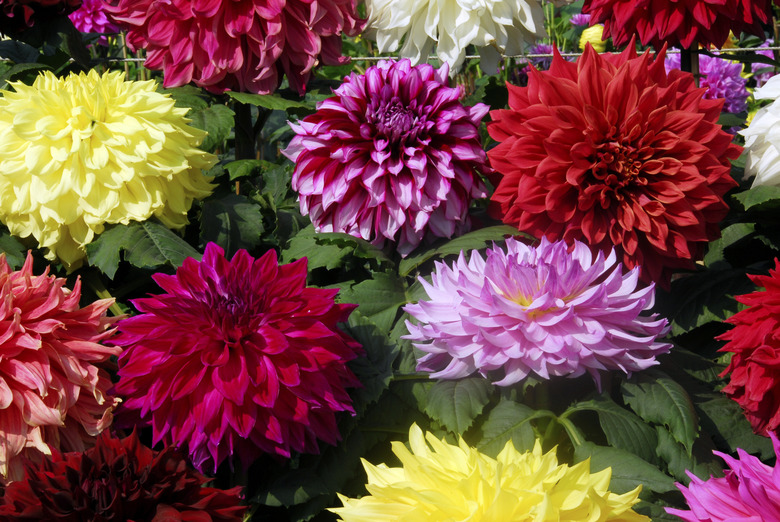How To Grow Dinner Plate Dahlias
Dinner plate dahlias (Dahlia spp.) produce showy 8- to 12-inch diameter flowers that attain the size of dinner plates. Their plants grow about 3 to 4 feet tall and will need wider spacing and heavier staking than smaller varieties. Dahlias can be hardy in U.S. Department of Agriculture plant hardiness zones 8 through 10 — and USDA zone 7, if heavily mulched. Wait until after the last spring frost date to plant their tubers, and never spray herbicides near the plants or you will kill them.
Step 1
Dahlias prefer full sun in all but the hottest climates and sandy, fertile loam with a pH between 6.5 and 7.0. Where summer temperatures sizzle, give them morning sun and afternoon shade. To lighten the soil and improve fertility, dig 2 inches of composted manure into the dahlia bed's top 1 foot of soil at least a couple of weeks before you plant them. For each tuber, make a hole 1 foot deep. After tossing a handful of bone meal into the hole, cover the meal with 4 inches of soil. Lay a dahlia tuber horizontally on top of that soil with its eye facing upward, and insert a 5- or 6-foot stake into the ground about 2 inches from the eye. Shovel 3 inches of soil over the tuber before making the next hole 3 to 4 feet from the first one.
Step 2
- Dahlias prefer full sun in all but the hottest climates and sandy, fertile loam with a pH between 6.5 and 7.0.
- To lighten the soil and improve fertility, dig 2 inches of composted manure into the dahlia bed's top 1 foot of soil at least a couple of weeks before you plant them.
Watering and Fertilizing
Step 1
If the soil is already damp, don't water it until the dahlia shoots begin to emerge. Irrigate dry soil only enough to keep it lightly moist as dahlia tubers rot easily at this stage. After dahlias send up shoots, gradually fill in the remaining soil around those shoots. When the holes are full and the plants are up, make sure they receive at least 1 inch of water per week. Once a week, feed them with 2 tablespoons of an organic liquid tomato fertilizer such as 4-6-2 mixed into 1 gallon of water.
Mulching and Weeding
Step 1
Don't mulch dahlias until after their holes are full and their shoots have emerged. At that point you can spread 2 inches of wood chips, straw or another organic material around them, keeping it away from their stems. If you can't mulch, it's best to weed dahlias by hand to avoid disturbing the tubers.
Step 2
- If the soil is already damp, don't water it until the dahlia shoots begin to emerge.
Thinning and Supporting
Step 1
When the shoots have reached 6 inches, thin them to leave only the two most vigorous ones on each plant. When those reach 1 foot, tie them loosely to their stakes with thick twine or other broad, soft ties. After each stalk has three sets of leaves, pinch back its tip to the topmost set of leaves to encourage branching out. As the plants grow, keep an eye on the flower buds, which will appear in clusters of three at the tip of each stem. Once they are the size of peas, remove the two side buds on each stem — leaving only the bud in the middle — to promote larger blooms. Continue to add more ties as needed to support the plant and its heavy flowers.
References
- Swan Island Dahlias: How to Grow Dahlias
- Utah State University: Growing Dahlias
- The American Dahlia Society: Fundamentals of Growing Dahlias
- Dahlia Barn: Dahlia Care
- The Plant Lover's Guide to Dahlias; Andy Vernon
- The New Sunset Western Garden Book; Kathleen Norris Brenzel, Editor
